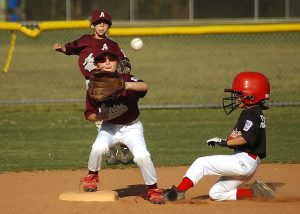Chapter Nine: School Age (5 Years to 8 Years)
Physical Development in School Age
Overall Physical Growth
Rates of growth generally slow during the early school years. Typically, a child will gain 5-7 pounds a year and grow about 2-3 inches per year (Kuczmarski, 2000). They also tend to slim down and gain muscle strength and lung capacity making it possible to engage in strenuous physical activity for long periods of time. Boys typically outperform girls during this period in gross motor tasks such as learning to ride a bicycle. Girls typically outperform boys during this period in fine motor tasks such as stringing beads or cutting one’s fingernails.
Brain Growth
During these early school years, children gain greater control over the movements of their bodies. Between ages 6 and 8, significant improvements in fine motor skills and eye-hand coordination are noted. They are able to master many gross and fine motor skills that eluded the younger child. There is a brain growth spurt between the ages of 6 and 8. Another factor related to brain growth is that between the ages of 6 and 12, the nerve cells in the areas of the brain associated with motor planning become almost completely myelinated. Children are better able to plan and coordinate activities using both the right and left hemispheres of the brain and are beginning to be able to control emotional outbursts. The ability to pay attention also improves as a function of continued maturation of the prefrontal cortex (Berk, 2017; Santrock, 2013).
Sports
 Children between the ages of 5 and 8 are often exposed to organized sports for the first time. It is also common for parents to give their children the opportunity to engage in other organized physical activities such as martial arts, horseback riding, gymnastics, or dance. The most popular organized sport for youth in America is soccer. Over three million children play soccer in the United States (United States Youth Soccer, 2018). Soccer is an activity that promises to help children build social skills, improve athleticism, and learn a sense of competition. Too much focus on competition and athletic skill is a concern, with many children desiring to quit. The focus for soccer and other youth sports and activities should be on building a love for the game or activity and allowing children to foster their natural talents.
Children between the ages of 5 and 8 are often exposed to organized sports for the first time. It is also common for parents to give their children the opportunity to engage in other organized physical activities such as martial arts, horseback riding, gymnastics, or dance. The most popular organized sport for youth in America is soccer. Over three million children play soccer in the United States (United States Youth Soccer, 2018). Soccer is an activity that promises to help children build social skills, improve athleticism, and learn a sense of competition. Too much focus on competition and athletic skill is a concern, with many children desiring to quit. The focus for soccer and other youth sports and activities should be on building a love for the game or activity and allowing children to foster their natural talents.
Some of the researched benefits of children’s participation in sports include better academic performance, improved physical and emotional development, and higher levels of satisfaction with family and overall quality of life.
Sabo & Veliz (2008) found in their study on children’s sports in the United States that gender, disability, ethnicity, poverty, and location all play a role in limiting opportunities for sports participation. Children living in suburban neighborhoods were more likely to participate in sports than those living in urban areas. Caucasian boys and girls participated in sports at higher rates than minority children.
Media Attributions
- Baseball © Image by Keith Johnston from Pixabay is licensed under a CC0 (Creative Commons Zero) license

